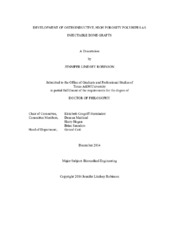| dc.description.abstract | Injectable bone grafts are space-filling materials that integrate with native bone to repair large defects from congenital deformities, trauma, and tumor resection. However, current injectable bone grafts limit healing due to lack of biodegradability, high temperatures during hardening, reduced porosity, and brittle compressive properties.
In this work, polymerized high internal phase emulsions (polyHIPEs) were developed as high porosity scaffolds for injectable bone grafting applications. Methods to modulate polyHIPE pore architecture, compressive properties, and degradation rates were established. Injectable polyHIPEs with pore sizes ranging from 1- 200 μm, compressive properties comparable to human cancellous bone, and degradation profiles spanning days to months were fabricated by altering compositional parameters (i.e. organic phase composition including macromers and surfactant, addition of an electrolyte in aqueous phase, and the phase in which initiator is soluble) and processing parameters (i.e. mixing speed, and cure and storage conditions). Cytocompatibility of all HIPE components was first verified and human mesenchymal stem cell (hMSC) adhesion and morphology was then assessed on polyHIPE sections. In order to confer an osteoinductive character to the bone grafts, calcium phosphate nanoparticles and demineralized bone matrix were incorporated into the polyHIPEs. PolyHIPE pore size and compressive properties were negligibly altered with the incorporation of particles. Alkaline phosphatase activity, a marker of osteoblast differentiation, was elevated from hMSCs on polyHIPE sections with osteoinductive particles. Finally, hMSC viability post encapsulation in the polyHIPE was investigated to demonstrate the potential use as a cell carrier and viable cells were observed at 3 hours post encapsulation.
Overall, these studies highlight the potential of injectable polyHIPEs as improved bone grafts that can deliver and retain autologous hMSCs at the defect site while also inducing osteogenic differentiation for enhanced bone regeneration. Elucidation of key structure-property relationships in emulsion templated scaffolds can be used in future studies to further modulate cell-material interactions. | en |


